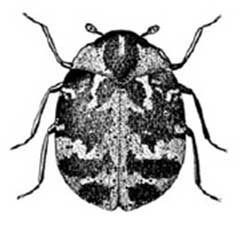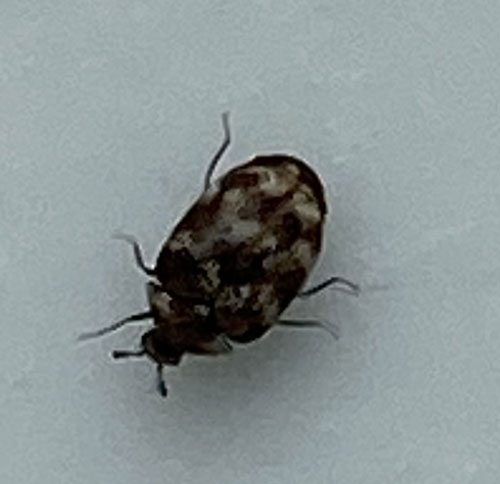Even in the cleanest home, there are also living creatures such as dust mites, fleas and other bugs that can call your carpet home. For example, have you heard of “woolly bears”? This is a colloquialism for a beetle that rather likes wool carpets. If you have ever seen a small beetle approximately 3 or 4 mm (⅛th inch say) dead on your window sill, it’s probably the carpet beetle (also known as a museum beetle). It has a zigzag cream and brown pattern on it’s back (wing-cases).
It is very common in the UK and a few years ago we had numerous phone calls regarding this beetle. It’s lava stage is a small cream furry looking “woolly bear” which is most commonly found on the edges of wool carpets. It basically eats the wool, your clothes – whatever, until it changes into a beetle and flies towards the light of the window. Most of them dehydrate and die on your window sill!

Adult
Common Carpet Beetle.
Anthrenus sp.

Larva
Carpet Beetle.
Size 2 or 3 mm
They are called museum beetles because when the Victorians started their great museum collections of silk robes etc., they very soon found “woolly bears” eating them. They can remain in the lava (woolly bear) stage for up to 2 years. It is due to this they can do considerable damage to your carpets and in particular your clothes. You see they prefer quality items like silk or wool pullovers. They can come into your house on birds nesting in the roof or just fly in your window on a hot summers evening.
How do you get rid of them? Through vacuuming – especially around the edges of the carpet, move furniture regularly to do this. If you do have a serious infestation though you need an insecticide sprayed down after the carpets have been thoroughly cleaned. We have the products to do this.
Dust mites are the most obvious unwelcome creature though. Most people don’t have a problem with them but if you are one of the people who has an allergy to the dust mite protein i.e. asthma, we can clean and treat your carpets (and uphol- stery, bedding etc.) with our unique anti dust mite allergen product. It works by locking into the dust mite faeces and de- activating the Der p1 antigen. It is this antigen which causes the allergic response in sensitive people.
Service Areas: Wirral, Heswall
